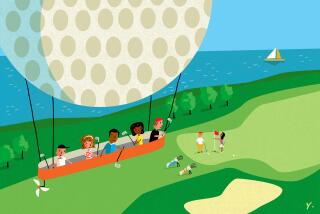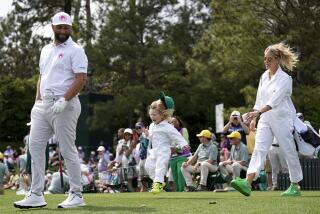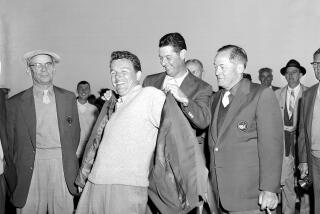Watch Out for Those Buried Lies
ST. ANDREWS, Scotland — They find them in the mornings, in the weeds, through the mist.
The workers unlock the ancient gates of the St. Andrews Cathedral cemetery, tread carefully around the century-old headstones, and there they are.
For the record:
12:00 a.m. July 15, 2005 For The Record
Los Angeles Times Friday July 15, 2005 Home Edition Main News Part A Page 2 National Desk 1 inches; 41 words Type of Material: Correction
British Open -- A photo in Thursday’s sports section of the St. Andrews cemetery with Bill Plaschke’s column from the British Open was credited to Max Rossi and Reuters. It should have been credited to the University of St. Andrews archives.
Golf balls.
Sometimes a dozen of them.
Stuck beneath dearly beloveds, lying atop in loving memorys, OB at the RIP.
Talk about a ghastly lie.
Nobody knows where the balls come from. Nobody knows why they are there.
The only thing certain is, the cluttered graveyard contains the burial sites of three former Open champions, a local champion, and dozens of others who played the game.
And, perhaps, are still playing it?
“All we know is, whoever is doing this, they don’t replace their divots,” stone mason George Miller said.
That, and nobody has ever heard a midnight wailing of “Fore!”
If they were true St. Andrews golfing ghosts, they would be polite ones, no? That is, unless they’re still tortured about John Daly.
“Golf is a part of life here,” Miller said, shrugging. “All parts of life.”
This year’s British Open begins today at the historic Old Course, about five Tiger tee shots from the graveyard, and if some strange things happen, consider yourself warned.
“I’ve been here at some pretty odd times and I’ve never seen anything,” Miller said, smiling through gaps in his teeth. “But there are stories ...”
Every morning when workers arrive at this seaside resting place, they find not only golf balls in the grass, but balls and tees and ball markers resting on the golfer’s graves.
“We especially like the ball markers because they’re, like, American money,” groundkeeper John Laing said.
Every day there is a parade of visitors to those graves, yet somehow the grass around them remains weedy and thick, an eternal rough.
“You would think it would be more patted down with all the people walking around, but it’s not,” Laing said.
And every night the workers leave and look at the stone wall and think, OK, somebody must climbing it, right?
“College kids, surely,” Miller said. “At least, we, well, think so.”
Other ghosts are more famous here, certainly.
There are three monks who reportedly live in an ancient tower in the middle of the grounds. The word is, two of them constantly fight until one crashes to the ground, while the other one stays inside and prevents visitors from falling on the stairs.
Then there is the infamous “White Lady,” who has been lounging on headstones wearing one white glove.
“We know about some ghosts, but there are lot of other things we just don’t know,” said Neil Rolland, a steward with Historical Scotland.
Why not bogey men?
The oldest recorded headstone in this place is 1609, so folks have been here awhile, maybe leading to the boredom that sometimes leads to the driving range.
And, certainly, they would already have the sticks.
Look at the stone commemorating Tom Morris Jr., a four-time champion beginning in 1868 and maker of history’s first official hole in one. Sculpted into the side of a stone wall that peers down to the beach, “Young Tom” is depicted swinging what appears to be a primitive wood.
A few yards over, on the headstone of Allan Robertson, one of the first St. Andrews members and a local champ, there are two clubs.
Nearby is the resting place of Willie Auchterlonie, who was an Open champion in 1893 and the first serious manufacturer of golf clubs.
The fourth champion here is Tom Morris Sr., who is considered the father of St. Andrews golf and a four-time champion.
Old Tom’s headstone has no decoration, but it doesn’t need it, because somebody is always leaving flowers.
“People take golf very seriously here,” Rolland said. “For many, it’s who they are.”
And who they want to be.
On this sunny afternoon, for long stretches, the wail of a Scottish dirge can be heard seeping through the walls.
It sounds like a recording. It’s not. On a secluded street outside, his case opened in front of him in universal fashion, a kilted street musician is playing the bagpipe for coin.
“I want to go in there, I want to be playing in there,” teacher Colin Morrison said, pointing to the cemetery. “But they won’t let me.”
Dying to get in, some. Dying to get out, others.
Then, perhaps, there are those, in the finest Scottish tradition, who are just dying to play through.
Bill Plaschke can be reached at bill.plaschke@latimes.com. To read previous columns by Plaschke, go to latimes.com/plaschke.
More to Read
Go beyond the scoreboard
Get the latest on L.A.'s teams in the daily Sports Report newsletter.
You may occasionally receive promotional content from the Los Angeles Times.











